Laos & Vietnam Giant Serpent Crossing the MekongMarch 2009
Rapidly changing Laos
The Mekong River flows calmly, but there is a ruffled spot on the river, from which clouds of spray are coming up. It is the Khone Falls in the southern part of Laos. In the jungle beside the waterfall remain a rail overgrown with grass and a rusty boiler of a steam locomotive. In the days of French territory they cut down teak trees and transported the logs by boat on the Mekong River, but they used a logging railroad in the section where the waterfall is located. Except for the logging railroad, there had been no railroad in Laos until March of this year, when the international train service started.
The opening of the railroad and the completion of the power station
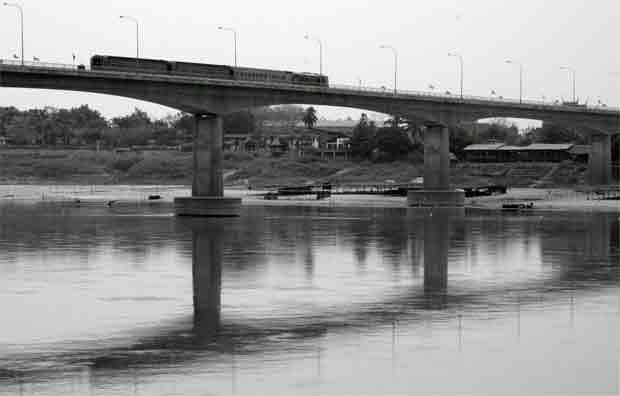
The railroad track was extended from Nong Khai Station on the border of northeast Thailand to newly-built Thanaleng Station in Laos. The distance between Nong Khai and Thanaleng is only 3.5 kilometers. The international train composed of a diesel-electric locomotive and three passenger cars shuttles between two countries twice a day, in the morning and in the afternoon. It is 15 minutes’ ride and the fare for an adult is 50 baht (about 150 yen). It was in 1994 that with aid from Australia the Mittaphap Bridge (Friendship Bridge) was constructed over the Mekong River, which forms the border. Since then buses have transported passengers and trucks have transported goods between two countries.
Laos seems to have intention of transporting heavy goods like oil from Thailand by rail, because Laos is a landlocked country with no coastlines. The railroad track was laid in the middle of the bridge, and the bridge is closed to motor vehicles only when the train is passing. When I was on the train on the day of mid-March, there were about 50 passengers and most of them were Thai tourists. They seemed to enjoy one day trip to a foreign country on the new international train rather than a visit to the places of scenic beauty and historic interest in Laos.
When you go to Vientiane, the capital of Laos, you have to transfer to a bus after entry formalities are done, and go toward the west for 40 minutes. So it is hard to say that it is convenient for travelers. In front of Thanaleng Station there is nothing but a large parking lot. There is not a souvenir shop.
The plan of constructing a hydroelectric power station on the Nam Theun River was come up in the 1970s, and the agreement on the concrete development project was signed by the World Bank, the Lao government and foreign enterprises in 1963. But the project was suspended because of the Asian monetary crisis in 1997 and the construction work did not start until November in 2005. In August of last year the sluice gates of Nakai Dam which secures water source for the power station were shut and a huge reservoir formed. It is a reservoir of 450 km2 at full supply level, which is equivalent to two thirds of Biwa Lake in Japan.
Is Laos really the poorest country?
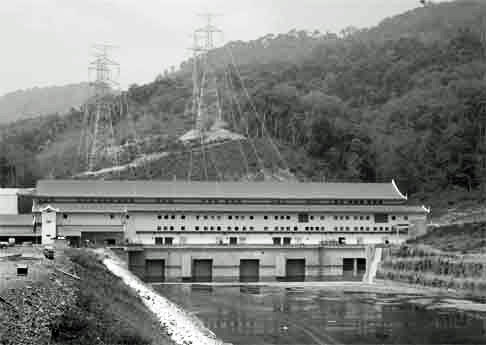
Mr. Maniseng Khamphay (56), the managing director of MK Tour in Vientiane said, “Laos’ attractions are beautiful nature and Lao people’s unsophisticated hospitality. I hope that the number of tourists will increase.” He, however, also said, “There will be no problem about the development because Laos has small population for its area.” He takes an optimistic view of development. “Without development, we have to live in the same way as the people of 2000 years ago did. Can you stand such way of living?” he said, laughing. Japanese people, especially of today, will not be able to stand such living conditions indeed. We cannot even think of living without electricity and of spending half a day to get to a hospital.
On the forested lands of Laos whose area is equivalent to about 60 percent of that of Japan only 6,070,000 people live. I presume that these circumstances may be a balanced point which decides whether man can coexist with other animals and plants as a part of the ecosystem, and that Laos may be one of the few paradises which remain on the earth. Do I have this sense of values because I am a passing foreigner? The United Nations defines a country whose gross national income per capita is under 750 dollars as a Least Developed Country (LDC), after consideration of assessments of national caloric intake, health index and literary rate, and share of manufacturing and service industries in gross domestic product (GDP). A LDC is generally called the poorest country.
According to this, Laos is one of the poorest countries. But income data used for the assessment criterion doesn’t include any data on harvest for home consumption and barter, labor and reclaimed land. Now the Lao government is aiming to emerge from poverty by 2020. So it is understandable that dam development is Laos’s trump card because Laos can obtain foreign exchange by selling electricity. However, there has been no famine in this country. Some Lao people fled from the country indeed, but they didn’t flee because of starvation. They fled from the civil war and the regime.
A government officer of the socialist government worrying about the development projects
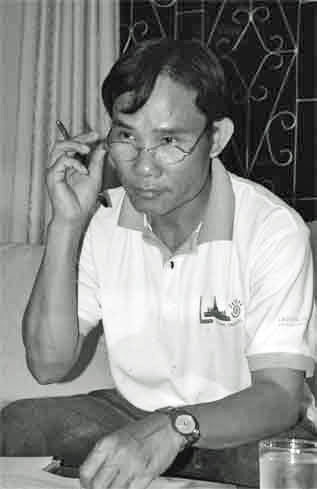
This year a Lao writer Houng Aloun Danvilay (47) received the Southeast Asian Writers Award. The winning work is a collection of short stories That Old Silk Skirt with the theme of development. One of the stories is “The field needn’t have been irrigated.” The outline of the story is that a farmer got his field irrigated, but when the price of his land rose he sold it and opened a store on the conveniently-located roadside. Houng Aloun said, “A farmer who wants to open a store or start in business doesn’t need an irrigation canal. The government has only to build a road.” He indirectly criticized the top-down project of development drawn up without reading popular mind. The story seems to indicate the future of the villagers who have received a good compensation for their loss caused by the construction of the dam.
Houng Aloun is a government officer working as a chief editor of the monthly magazine in the Ministry of Culture. Judging from that he is highly thought in the government, citizens of Laos seem at least to have freedom to express their own opinions on the merits and demerits of development, though Laos is a socialist country ruled by one party. He stopped proofreading and started to prepare for dinner. He continued, “Development affects the “sweet” parts of the society. We can see fewer and fewer scenes where people grow leeks, mint and garlic in their garden, and share home-made laap with their neighbors. You know, a person who goes after someone can choose better way. For instance, when a man walking at the head is attacked by wasps in the jungle, the next man will take another way.”
Fixed-point coverage after an interval of 15 years
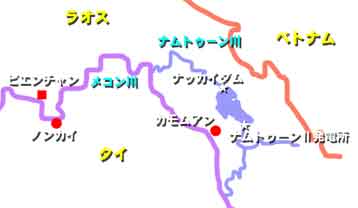
In 1994 when the Nam Theun-2 Power Station Project was taking shape, I visited a village on the Nakai Plateau to make a report because I heard that the village was going to be submerged under the dam lake. At that time the villagers lived nearly self-sufficient lives, growing glutinous rice in the rice field, gathering vegetables and small animals in the woods, and making daily necessaries or building a house with materials from the woods. The headman of the village remarked then, “I don’t want a dam as a villager, but we have to obey the decision by the government and when the reservoir is made we can catch fish, and then a market will be made, so we can sell the fish. Maybe we will be able to make a better living.” During two years from April 2006, about 6,800 people from 1,236 households in 17 villages left their old homes and moved to new places 1 to 15 kilometers away from where they had lived, and formed 17 new villages with the same names as before.
The vice chief (60) of the agriculture department of the Ministry of Agriculture and Forestry was one of the persons in charge of research for the dam construction on Nakai Plateau in the early half of 1990s. “Our country still has the most forests in ASEAN, and we can produce as much electricity as we need, thanks to the mountains and the Mekong River. We are aiming to be a “battery for ASEAN.” However, we cannot generate hydroelectricity without the water holding capacity of forests. If were not for water, a dam would turn into just a huge monument.” The Ministry of Agriculture and Forestry are planning to increase the forest cover in the country from the present 42 % to 70 % by the year 2020. They allocate forests into three categories — for a nature reserve, for a dam reservoir and for an industry. And they impose limits on reclaiming for plantations. They also put a ban on the traditional slash-and-burn method of agriculture, and encourage organic farming and cattle breeding. The vice chief talked proudly about their project. But regarding to the view that Nakai Plateau is a rich repository of species including undiscovered animals and plants, we talked at cross purposes.
A scientist feeling abashed
The assessment of impacts on environment was carried out by the Nam Theun-2 Power Company, so there was not an option of canceling the construction of the dam, though they emphasized they had spent as many as 10 years on the assessment. During this visit, I had a chance to talk with a Laotian who was in charge of compensation in the power company for the inhabitants’ loss. The man forty or so, who took a doctor’s degree in a country where he had stayed as a student, told me the actual facts, on the condition that I would not reveal his name. His job is to examine the conditions of finance, education, medical care and culture of villages whose villagers are ordered to leave, and offers appropriate places for resettlement and compensation. If villagers accept the offer, he arranges for their movement and watches over them after that. When I asked how difficult the assessment was, he said there were no records on the statistics of village gross product, the number of schoolchildren or the species of animals and plants. No one, including a village headman, had taken the statistics and no one was capable to do that. He also said that he had tried to research on animals and plants but the Lao government had refused his entrance to the area. Even if it is said the assessment was made as a pose, it can’t be helped in a sense,” he said. He seemed to feel ashamed of himself as a scientist.
Overcompensation?
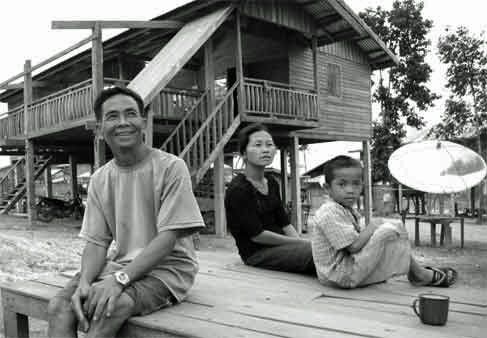
In the resettlement villages the power company built houses for the villagers, and dug wells at the rate of one well per five houses. And they supply the villagers with electric power free of charge for the time being. Besides the houses, they built at least six public buildings, such as an elementary school, a day nursery, a village office, a village conference hall, a market, a warehouse and a rice-cleaning mill. In addition, they built two health centers for 17 villages and provided four cars with four-wheel drive as ambulance and twelve motorbikes. Moreover they run a sawmill to saw up logs or make furniture and folk crafts, and they support the Nakai Plateau Village Forestry Association (VFA) that supplies young plants for plantations.
I met the former village headman (57) at his resettlement village for the first time in 15 years. He said, “This is a nice place. We have water and electricity here. The power company built us houses.” He seemed to be satisfied with the compensation by the power company. About half the area of the former village, which was located one kilometer north away from here, has already gone under water. But he said, “I don’t feel sad about having lost our village. Because I found this place better. Our forest was all dead, but we can make a living by fishery. A boat is very convenient.” His wife (46) said, “In the old village we had to walk one kilometer to draw water, but here we can draw clean water from a well near our house. Now that a nice road was built, we can go anywhere we like.” Nursing her grandchild in a newly-built big house, she looked happy.
The Nam Theun-2 Power Station is a dam and conduit type power station. In this system water from the river on the plateau flows into the reservoir created by the dam, and falls through the conduit. Near the sluice gate I saw some people landing fish from a boat. The catch of one-time fishing is about five kilograms per boat. A trader will buy the fish at about 130 yen per kilogram. They are packing the fish and ice into boxes of foam polystyrene provided by the trader. The fish they caught in the river used to be only for home consumption because the road was so bad that they couldn’t go to sell it. Since the power company provided 600 glass fiber boats, 50 wooden boats and fishing gear including nylon nets, the villagers could start fishing in the newly emerged lake.
Indications that ecosystem is changing
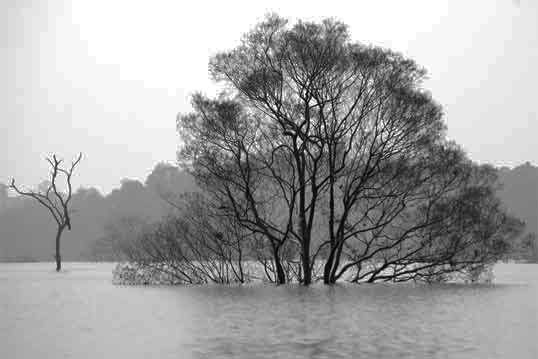
The power company is going to examine the quality of the dam lake every week and research the inhabitants in the upper and lower streams from the dam. The company is also going to create 30 marshes to protect wild animals such as Asian elephants and tortoises and patrol the places to guard them against poaching.
However, when we ran through the dam lake, we only saw bleached white dead trees sticking out of water. It looked as if it were the world of death. The place was so weird that it could be used as a location for a SF movie. Near Nakai Dam I met two fishermen who were steering a blue and white two-tone boat that had been provided by the power company. Although their village located down the dam was not submerged, the villagers can’t catch fish at all, therefore, they have to come to the dam above their village. They were catching “gun” fish by the long-lining method. By selling the fish they earn 50,000 to 60,000 kip (about 550 yen) a day. I asked them to show me the fish they caught. All of them were ‘gun’ fish which looked like a torpedo. They were the same kind of fish as I had seen at the sluice. Not so many kinds of fish live in this lake.
The former village headman, who used to live self-sufficient life with the blessing of forest, noticed that the ecosystem was changing. He said, “The water level is rising and animals are running away into the deep of the jungle. We can still get some vegetables but ‘bon’ bamboo has disappeared.” The villagers now buy vegetables and meat with the money that they earn by selling the fish they caught in the dam lake. Their lifestyles are changing greatly. Since their lives suddenly became easy, they seemed to be in raptures and not to be able to think of their lives five or ten years from now.
Attentively drawn-up but hastily started because it was a pilot project
There are other large-scale projects to build dams for hydroelectric power generation in the main course of the Mekong River. The governments of Laos, Thailand and Cambodia have given private enterprises permission to conduct the feasibility study on building dams in eight places ranging from Pakbeng in the northern part of Laos to Sambor in Cambodia until November 2007. Since the project for constructing Nakai Dam and Nam Theun-2 Power Station is the first large-scale project for the development of the Mekong basin, it seems that exemplary measures have been taken in order to obtain further international support. The Nam Theun-2 Power Company announced on its website for the parties concerned that they would continuously compensate the villagers who were ordered to leave their places until 2015 and that they would endeavor to protect the environment. However, the statistics which should be the basis for compensation are very sketchy and questionable. There are some worries that too much compensation might discourage the villagers from working and change their sense of the value of money.
Is the dam really beneficial?
Skeptical about ‘the sustainable socio-economic development’ advocated by the government and enterprises, an NGO ‘Towards Ecological Recovery and Regional Alliance’ has been watched the dam development project carefully since the latter half of 1980s. The co-director of the NGO, Premrudee Daoroung (44), said, “It was a very sensitive issue to build a dam lake on the Nakai Plateau, which is the most valuable natural environment area in Laos. We have seen the government and enterprises do no research. We are very worried that the dam may hinder the seasonal migration of fish and that the decrease in the number of fish may affect the villagers’ living directly. We have lost irreplaceable asset, yet is this dam really beneficial?”
According to the plan by the Lao government, banks, and enterprises, 95 % of the electricity generated by Nam Theun-2 Power Station is exported to Thailand, and the Lao government will complete the construction loan repayments in 25 years, and then the dam will be transferred from the power company to the Lao government. However, the capitalistic economy is now held in check and it is proved that the economy will never keep growing forever. Then, is it all right that the perpetual nature which will never be restored with money can be sacrificed for profits yielded per a period of several decades?
The Laotian with a doctor’s degree didn’t reveal his identity because he is employed by the power company, but he gave me a mysterious suggestion at our parting. “I think you should stop at the construction site of Nam Theun-1 on the way to Vientiane.” So, taking Route 13 which runs parallel to the Mekong River in Pakkading District of Borikhamsay Province, I went into the mountain. When I crossed the ridge, I saw the Nam Theun River, a tributary of the Mekong River. At that moment I understood what the Laotian’s suggestion conveyed. The greens of the mountain were cut out and its surface was exploded and covered with concrete. Although a wide road and ditches were made, there was no one to be seen, and the surroundings were as unearthly silent as the grave. According to the man who was taking charge of the heavy machines gathered in a place, the construction of Nam Then-1 Power Station started two years ago, but it was suspended last December, because Thailand, a buyer for electricity, was hit by global depression and asked for a reduction in power rates. As a result Laos couldn’t obtain additional loan. It is still unknown when the construction will be resumed. And also there is a rumor that the construction machines and materials will be put up to auction. Laos is trying to get rid of poverty by exporting electricity, but it cannot avoid being affected by the fluctuation of the world economy.
There is an old saying in this country which has been passed on since the reign of King Lan Xang in the 14th century. It goes, ‘When a stone tortoise floats in the Mekong River and a giant serpent crosses the Mekong River, Laos will develop forever.’ Suppose that a stone tortoise indicates Mittaphap Bridge and a giant serpent indicates the international train. What direction is Laos developing in? That’s the important question.

